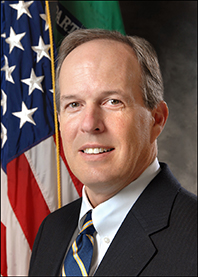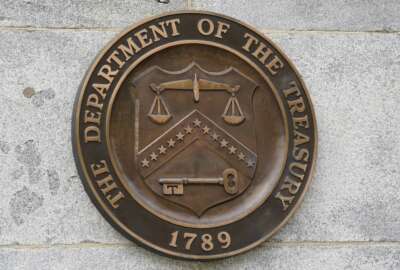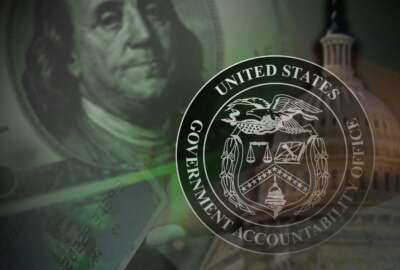New strategy, A-123 update to help reduce improper payments
David Lebryk, the fiscal assistant secretary at Treasury, said a new strategy provides tools, best practices and guidance to improve federal payments.
New tools and better data are putting the CFO community in a stronger position to do more to reduce improper payments and fraud in federal programs.
The Joint Financial Management Improvement Program (JFMIP) recognized this opportunity in its new three-year plan that it hopes can spur even more progress to ensure agencies are paying the right amount to the right people in a timely manner.
David Lebryk, the fiscal assistant secretary at the Treasury Department, said the JFMIP three-year strategy outlines three pillars of effort that will give agencies tools, best practices and guidance to do more to prevent fraud and improper payments.

“It’s focusing on prevention. It’s promoting best practices, and it’s strengthening the partnerships. The Treasury piece that I think is very much important here is focusing on that prevention. What tools can Treasury bring to the payment process that can actually really help reduce and prevent process fraud from happening?” Lebryk said on Ask the CIO. “The second pillar, which is promoting best practices, was about working with agencies. The Office of Management and Budget has done some good work with this, as well as when a new program has stood up. Do you put controls in place up front that help reduce the potential for improper payments? There are really a number of things you can do like doing risk assessment in your program and you can talk about different data that you need from recipients that you can get from them.”
As part of the focus on prevention, Lebryk said his office has launched several programs where Treasury followed many of the steps outlined in the JFMIP strategy to prevent and reduce fraud in large programs.
In helping local communities recover from the Deep Horizon oil spill back in 2010, Lebryk said ahead of implementing the Resources and Ecosystems Sustainability, Tourist Opportunities, and Revived Economies of the Gulf Coast States Act (RESTORE Act), Treasury designed the program to make sure recipients understood the requirements to apply for funding as well as controls to make sure the money went to the right people.
“We’ve had no fraud in that program that we’re aware of because we’ve really focused on those controls in the design of the program up front. We haven’t had an issue about slowing payment down. It does prove there’s opportunity, both to be quick, but also careful in the issuance of money,” he said. “In the third pillar, which was strengthening partnerships, it comes down to doing more with the states, the inspector general community and other government agencies to really strengthen those partnerships. I think we’re very confident that it’s going to have a real major impact and there’s a real commitment across the different entities to make sure it works.”
Increased focus on improper payments
The JFMIP strategy outlines strategies and objectives for each pillar based on the work by Treasury, OMB, the Government Accountability Office and others.
Both Congress and the Biden administration have increased focus on preventing fraud and improper payments as well as recovering lost money due to bad actors. The Government Accountability Office estimated that agencies spent $236 billion improperly in fiscal 2023, which was down about $11 billion, as compared to 2022.
On Capitol Hill, lawmakers have introduced at least eight bills since February 2023 focused on improper payments and fraud. A recent one from Sen. Gary Peters (D-Mich.), chairman of the Homeland Security and Governmental Affairs Committee, called the Fraud Prevention and Recovery Act, would, among other things, give resources to agency IGs to investigate people who committed pandemic fraud and recover the taxpayer dollars and create a new fund to help agencies prevent fraud and identity theft through a new early warning system for detecting fraud.
The Justice Department’s COVID-19 Fraud Enforcement Task Force (CFETF), for example, reported in April that it “charged more than 3,500 defendants, seized or forfeited over $1.4 billion in stolen COVID-19 relief funds, and filed more than 400 civil lawsuits resulting in court judgements and settlements” since it launched in 2021.
Another administration priority is the rewrite of Circular A-123 internal controls for overseeing and administering programs. OMB’s last major rewrite was in 2016 when it added risk management to its updated internal control processes.
Making A-123 less compliance-based
Lebryk said one of the goals of the A-123 rewrite is to reduce the compliance requirements and make the circular more usable.
“We want to make it less of a compliance exercise and more of a real actual set of practices that will help agencies. Some agencies have been further along in terms of setting up internal programs to actually adhere to the spirit of A-123 and here to the spirit of really trying to reduce the improper payments,” he said. “But again, it’s less so about paperwork and reporting, and more so about how do you make sure you actually make an impact in this area. I think the CFO community can be very helpful in this regard. The CFO community plays a very unique role in that we’re supposed to speak the truth. We have an obligation to raise our hand and say, ‘hey, something isn’t necessarily looking right on the financials.’ We want to make sure that we have integrity and stewardship of government resources, so I think that we can do a better job in a financial community of saying to program agencies, ‘hey, the one way to create problems for you not to be able to meet your program’s mission, is if you do have things like fraud because it means that the right people aren’t getting the money.’”
Treasury already has several tools on new and existing platforms and databases to help agencies move from being reactive to proactive in stopping fraudulent payments. One tool uses machine learning to look for anomalies on paper checks. So far, Treasury has run about 40 million checks through the ML application.
Lebryk said Treasury is the co-chairman of a CFO Council working group, which is determining the impediments for agencies to use these and other fraud prevention tools.
“They’re also doing some important work about creating a fraud catalog that collects trends and fraud, which I think is also very important. But one of these really important workstreams is for us to say, ‘hey, is there something that Treasury can do to make it easier for you to access these tools?’” he said. “Having looked at the government environment over a number of years, one of the real challenges that you have is asking someone to make a systems change. It is a very lengthy, long process because, quite frankly, oftentimes system changes aren’t funded. They can be difficult. So what we’re really looking at is whether there is opportunity for technology to help in this, in terms of things like interfaces with existing systems, which can make it easier to interact. Are there just organizational issues within the agencies that would be helpful if the agency was organized slightly differently or had the information going in one place versus another place, that would mean that you could take action?”
Lebryk added the committee will make a series of recommendations that would lead to improvements with a goal by the end of the year identifying a set of tools that agencies can take more advantage of to prevent fraud and improper payments.
Copyright © 2025 Federal News Network. All rights reserved. This website is not intended for users located within the European Economic Area.
Jason Miller is executive editor of Federal News Network and directs news coverage on the people, policy and programs of the federal government.
Follow @jmillerWFED







